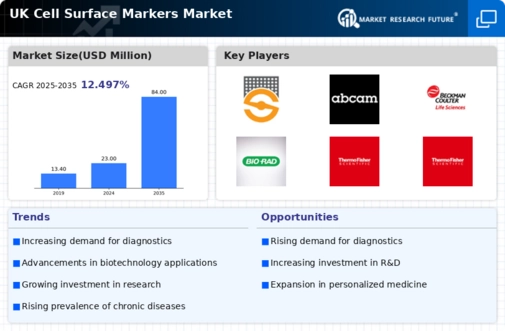The UK Cell Surface Markers Market is characterized by a dynamic competitive landscape, influenced by the increasing demand for advanced diagnostic and therapeutic applications in molecular biology and immunology. As the biotechnology and pharmaceutical industries continue to expand, the need for efficient and accurate cell surface markers has grown significantly. This has led to a variety of companies enhancing their product offerings and innovations, concentrating on specific market needs such as monoclonal antibodies, proteins, and other biomolecules that identify specific cell types.
The competition among key players is intensified by ongoing investments in research and development and the establishment of partnerships and collaborations aimed at driving technological advancement and improving market penetration.F. Hoffmann-La Roche, a prominent player in the UK Cell Surface Markers Market, is well-regarded for its strong focus on innovation and quality. The company has a substantial market presence supported by a robust portfolio of diagnostic and therapeutic products, particularly in the areas of oncology and immunology. F.
Hoffmann-La Roche's strengths lie in its ability to leverage cutting-edge technology and research, leading to the development of highly specific and effective cell surface marker assays. This emphasis on state-of-the-art solutions enables the company to maintain its competitive edge and address the evolving needs of researchers and healthcare providers in the UK. Furthermore, the company's dedication to high standards and regulatory compliance ensures trust and reliability among its clientele. Stemcell Technologies is another key player in the UK Cell Surface Markers Market, recognized for its commitment to empowering research and development in cell biology.
The company specializes in providing a range of high-quality products, including cell separation and culture solutions, which are essential for various applications associated with cell surface markers. Stemcell Technologies has a strong market presence driven by its reputation for innovation and the provision of superior customer service. Its key products, such as antibody-based cell separation technologies and optimized cell culture media, cater to both academic and industrial researchers focusing on stem cells and immune cells. The company has also expanded its influence through strategic collaborations with academic institutions and other biotech firms.
Through these partnerships and its continuous investment in product development, Stemcell Technologies further solidifies its position in the UK market, showcasing its strengths in providing reliable solutions that meet the nuanced needs of researchers exploring cell surface markers.




















